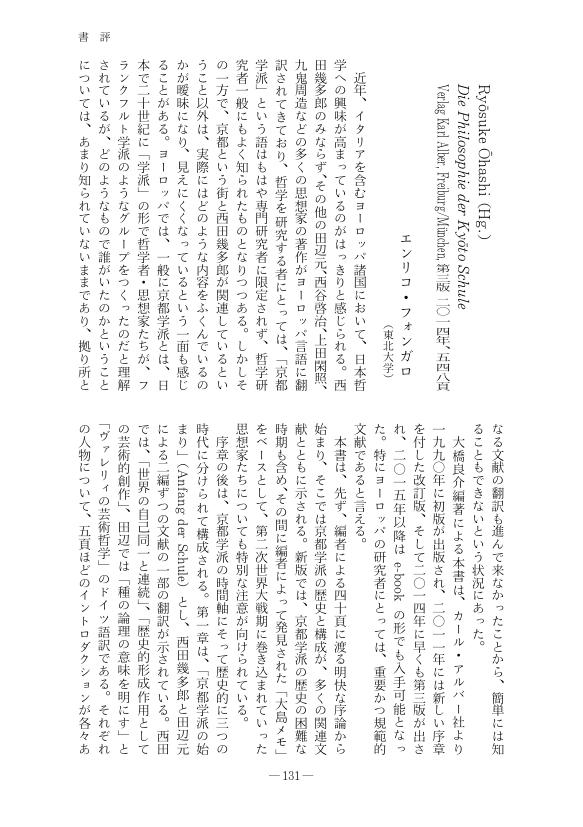- 著者
- 林 良子 フォンガロ エンリコ
- 出版者
- 神戸大学
- 雑誌
- 国際文化学研究 : 神戸大学国際文化学部紀要 (ISSN:13405217)
- 巻号頁・発行日
- vol.31, pp.133*-146*, 2008-12
1 0 0 0 OA 西田哲学の翻訳における諸問題 「感情」をきっかけとして
- 著者
- フォンガロ エンリコ
- 出版者
- 東北哲学会
- 雑誌
- 東北哲学会年報 (ISSN:09139354)
- 巻号頁・発行日
- vol.35, pp.51-64, 2019 (Released:2022-07-30)
- 著者
- フォンガロ エンリコ
- 出版者
- 西田哲学会
- 雑誌
- 西田哲学会年報 (ISSN:21881995)
- 巻号頁・発行日
- vol.14, pp.131-134, 2017 (Released:2020-03-21)
1 0 0 0 OA The Giotto’s O
- 著者
- フォンガロ エンリコ
- 出版者
- Nishida Philosophy Association
- 雑誌
- 西田哲学会年報 (ISSN:21881995)
- 巻号頁・発行日
- vol.9, pp.174-186, 2012 (Released:2020-03-22)
Despite the large diffusion beyond boundaries of the academic world, the 2007 Italian translation of Zen no kenkyū hasn’t yet had a wide impact among Italian researchers of philosophy. Besides an ongoing ignorance of non-Western cultures, one of the principal reasons seems to be a kind of recalcitrance to a real intercultural dialog, which Nishida’s texts constrain. Zen no kenkyū appears in fact as the fulfillment of a creative encounter of different cultures, where the limit between East and West is exceeded in favour of something that forces the readers to bring themselves into question. Therefore the reading of Zen no kenkyū seems to be often confusing, especially when, under the appearance of something very familiar, an alterity is suddenly discovered, that becomes a constitutive element of something new and unexpected. An example of it can be found in the interpretation of the famous episode of “Giotto’s O” in the Lives of Vasari, that Nishida inserts in the third part of Zen no kenkyū. This interpretation departs notably from the usual Italian one, focused on some features typical of the Renaissance thought and aesthetics. Nishida’s ≪Giotto’s circle≫, although it calls to mind Zen paintings such as ensō or full moons, is something different, so that it is impossible to put it merely aside as “Oriental thought”. Giotto’s quotation in Zen no kenkyū, on the contrary, familiar and alien at the same time, goes deep hitting the sensibility of the Italian readers, compelling the question of interculture, that is recently beginning to be considered in Italy as a necessity or a destiny.

